 klaus-michael schneider
klaus-michael schneider
Keywords: education |
Links: FOTW homepage | search | disclaimer and copyright | write us | mirrors

Last modified: 2021-05-22 by  klaus-michael schneider
klaus-michael schneider
Keywords: education |
Links: FOTW homepage |
search |
disclaimer and copyright |
write us |
mirrors
![[Flag of Colombia]](../images/c/co.gif) (2:3)
(2:3)  image by Željko Heimer, 20 May 2001
image by Željko Heimer, 20 May 2001
See also:
 image by Ivan Sache, 8 July 2014
image by Ivan Sache, 8 July 2014
Colegio Claretiano El Libertador was established on 15 April 1951 in Bosa
(Bogotá) by Luís María Hidalgo Dueñas, Benedicto Orjuel, Jorge Parra, Luís
Garavito, Manuel Poveda and Pedro Crisólogo Prieto. The institute was acquired
on 1 July 2010 by the Congregation of Missionaries Sons of the Immaculate Heart
of Mary (Claretians). The Claretians are a congregation founded on 16 July 1849
by the Catalan priest Anthony Mary Claret (1807-1870; canonized on 7 May 1950 by
Pope Pius XII).
The flag of the institute is horizontally divided
white-green.
http://ivaneamigos.wix.com/colegio#!informacion-general/vstc1=simbolos -
Institute's website
Ivan Sache, 8 July 2014
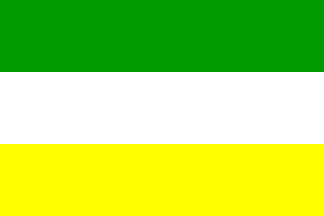 image by Ivan Sache, 16 November 2014
image by Ivan Sache, 16 November 2014
Institución Educativa Claudia María Prada (Colcama) is located in Cúcuta
(Norte de Santander Department). The college is named for the engineer Claudia
María Prada (1964-1999), who was abducted by the guerilla while
supervising the
building of a school in the Buenos Aires borough of Cúcuta and killed two days
later in Villa Sucre (municipality of Arboledos, Norte de Santander) during the
assault by the Army.
The flag of Colcama is horizontally divided green-white-yellow. Green is a
symbol of aspiration to a better future for the youth. White is a symbol of
peace and honesty of the institute. Yellow is a symbol of human resources in
their multiple dimensions.
Source:
http://colclama.edu.co/portal/nuestro-colegio/simbolos/ - Institute's
website
Ivan Sache, 16 November 2014
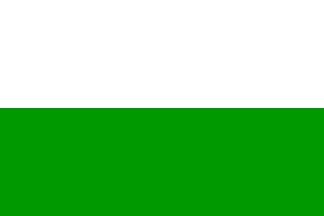 image by Ivan Sache, 28 January 2009
image by Ivan Sache, 28 January 2009
"Colegio 'Clemencia de Caicedo'" was created in 1967
by the Federal District of Bogotá (Decree No. 1667), succeeding
the girls' section of "Colegio Nacional Restrepo
Millán", founded the same year (Decree No. 1124).
The institute is named after Clemencia de Caicedo (also written
Caycedo), who founded in 1770 in Santa Fé de Bogotá
"Convento de La Enseñanza", the first girls' school in
the town, today "Colegio La Enseñanza".
The flag of the institute, as shown graphically on the website
of the institute, is horizontally divided white-emerald
green. Emerald green represents hope.
Ivan Sache, 28 January 2009
 image by Ivan Sache, 27 July 2018
image by Ivan Sache, 27 July 2018
Institución Educativa Colegio Club de Leones was established by Municipal
Decree No. 3, issued on 26 January 2005. Originally founded as Escuela Urbana
Club de Leones in March 1988, the school was renamed to Colegio Basic by Decree
No. 1,032, issued on 18 December 2001. From 2002 to 2005, the school was a seat
of Institución Educativa Misael Pastrana Borrero.
The flag of IE Colegio
Club de Leones is horizontally divided purple-yellow. Purple is a symbol of
fierce, while yellow is a symbol of rich values.
https://www.webcolegios.com/circulares/b4b804.pdf
Manual de Convivencia
Ivan Sache,
27 July 2018
"Colegio COFREM" was founded by "Caja de
Compensación Familiar Regional del Meta" (COFREM) in
Villavicencio, Department of Meta, for the education of adults.
Classes started in 1974; the current name of the institute was
approved by the Municipality of Villavicencio on 25 November 2004
(Decree No. 792).
The flag of the
institute, as shown graphically and described on the website of
the institute, is yellow with two thin horizontal green
stripes near the bottom and the emblem of COFREM in canton.
Yellow represents the resources and services provided by COFREM.
Green represents the aspiration to provide workers with better
life conditions through services and education
The emblem of COFREM, designed in 1985, is inscribed in an
hexagon, with all angles equal, and in a circle, whose radius
equals the hexagon's radius, representing COFREM as a trustable
entity. The emblem includes green arrows, pointing inwards, and
yellow arrows, pointing outwards, representing inputs and
outputs, respectively. Inputs are represented in green to
symbolize hope and easy communication, safety of inputs and trust
in the results. Outputs are represented in yellow to symbolize
vitality, warmth, and the good results of the programs set up by
COFREM.
Ivan Sache, 10 January 2009
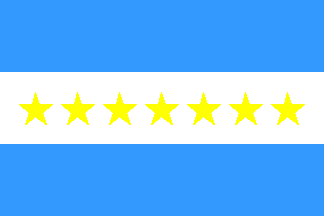 image by Ivan Sache, 13 March 2017
image by Ivan Sache, 13 March 2017
Institución Educativa Colegio Angulo originates in Centro Educativo Colegio
Angulo, established on 5 May 2004 in Angulo, Girón, Santander Department, by
Resolution No. 648. The institute was originally composed of four schools:
Angulo, El Pantano, El Alto de la Aldea, and Altos de Llano Grande.
Institución Educativa Colegio Angulo was established on 9 March 2010 by
Resolution No. 446, adding another three schools to the institute: Cantalta,
Potrero Cerrado, and Guaimaral.
http://colegioangulogiron.blogspot.fr - Institute's website
The
symbols of the institute were adopted in 2005 by a common agreement among the
teachers of all the schools forming the institute. The flag is horizontally
divided celestial blue-white-celestial blue with seven yellow stars in the white
stripe. Celestial blue symbolizes the tranquility of the region. White is a
symbol of peace and innocence. The stars represent the seven schools forming the
institute.
http://colegioangulogiron.blogspot.fr/p/simbolos.html - Institute's website
Ivan Sache, 13 March 2017
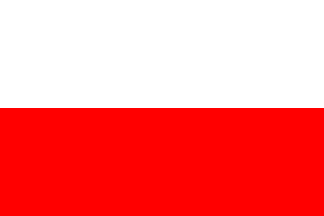 image by Ivan Sache, 16 December 2008
image by Ivan Sache, 16 December 2008
The "Colegio Odontológico Colombiano" was founded
in 1974 by odontologists who had graduated in the University of
Buenos Aires (Argentina) and in the National University
(Colombia), led by Pr. Dr. Jorge René Arango Tamayo. The
original "Fundación Colegio Odontológico Colombiano",
officially recognized by the Ministry of Justice on 9 May 1974
(Decree No. 2087), was quickly transformed into a University
Institute, recognized by the Ministry of National Education on 1
April 1975 (Decree No. 1384). Classes started on 28 July 1975.
Following the reform of the Ministry of National Education, the
institute was renamed "Institución Universitaria
Colegios de Colombia UNICOC" on 6 November 2007 (Decree No.
6753); the scope of the institute was increased beyond odontology
and related matters with the addition of two programs in social
sciences (law and political sciences) and economic sciences
(international trade and health administration).
The flag of UNICOC is shown graphically on the institute's
website as horizontally divided white-red.
Ivan Sache, 16 December 2008
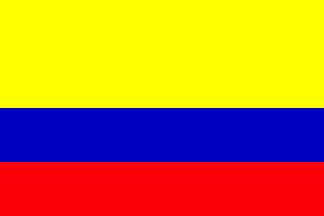 image by Ivan Sache, 13 May 2021
image by Ivan Sache, 13 May 2021
Colegio Colombia Mafalda is located in borough José Maria Obando, Popayán (Cauca).
The flag of Colegio Colombia Mafalda is identical to the national flag of Colombia.
Source: school website
Ivan Sache, 13 May 2021
 image by Ivan Sache, 13 May 2021
The flag of Kindergarten Llano Llargo, part of the same institute, is horizontally divided orange-white.
image by Ivan Sache, 13 May 2021
The flag of Kindergarten Llano Llargo, part of the same institute, is horizontally divided orange-white.
 image by Ivan Sache, 08 November 2014
image by Ivan Sache, 08 November 2014
Colegio Colombo Británico is located in Envigado (Antioquia Department).
The flag of the institute is horizontally divided white-gray-green with the
institute's emblem in the middle. The colours are those of the student's
uniform. White is a symbol of peace, innocence, purity, felicity, and harmony.
Gray is a symbol of intelligence, creativity, stability, tranquility, and
elegance. Green is a symbol of ecology, hope, and friendship.
Source:
http://www.ccbenv.edu.co/britanico/institucional-2/nuestros-simbolos/ -
Institute's website
Ivan Sache, 08 November 2014
 image by Ivan Sache, 1 January 2021
image by Ivan Sache, 1 January 2021
Gimnasio Colombo Británico is located in Bogotá.
The flag of Gimnasio
Colombo Británico is horizontally divided black-white-black.
Photo
http://www.americangarden.edu.co/gimnasio-colombo-britaacutenico.html
Ivan Sache, 1 January 2021
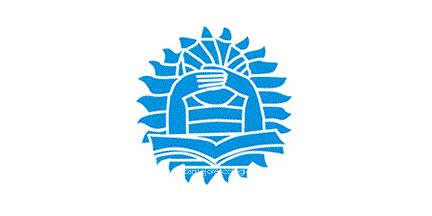 image by Ivan Sache, 26 July 2014
image by Ivan Sache, 26 July 2014
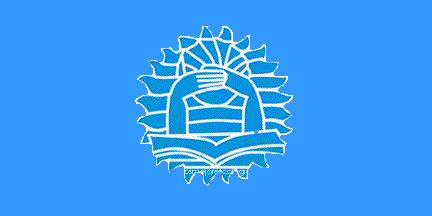 image by Ivan Sache, 26 July 2014
image by Ivan Sache, 26 July 2014
Colegio Colombo Galés is located in Bogotá.
The symbols of the institute are prescribed in Article 3 of the Etiquette Guide.
The flag of the institute is white with the institute's emblem in the middle.
The emblem of the institute includes a sun, as a symbol of arts, academics, and
universality, and a book, as a symbol of values, originality, and competitive
spirit.
Source:
http://www.colegiocolombogales.edu.co/descargas/category/2-varios?download=3:manual-de-convivencia
- Institute's Etiquette Guide
The flag appears to be used also with a blue background.
Source:
http://dircolegios.com/colegio-colombo-gales/
Ivan Sache, 26 July 2014
And what is the writing at its bottom?
Peter Hans van den Muijzenberg, 13 August 2014
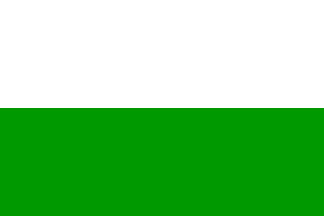 image by Ivan Sache, 28 January 2009
image by Ivan Sache, 28 January 2009
"Colegio Colombo Inglés" was founded in 1972 in
Valledupar, Department of Cesar, by the Watson Briceño family.
Classes started on 20 January 1973.
The flag of the institution, as shown graphically and described
on the website
of the institution, is horizontally divided white-green.
White symbolizes purity, peace, innocence and tranquility of our
children, the nobleness and transparency of the education
provided in the institute, and the light guiding the whole
community with honesty and beauty.
Green symbolizes hopes, children's' touch, friendship and
sociability, as well as balance and tranquility.
Ivan Sache, 28 January 2009
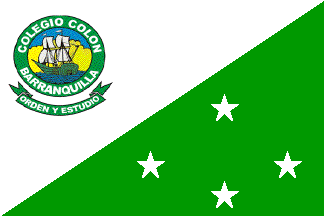 image by Ivan Sache,
6 July 2014
image by Ivan Sache,
6 July 2014
Colegio Colón was established on 15 June 1939 in Baranquilla (Atlántico
Department) by Ricardo Gordó y Fornés, a Spanish educationalist owner of a
PhD
in Philosophy (University of Valencia) and of a Ph.D. in Law (University of
Madrid). In 1943, the founder of the institute had to emigrate to Argentina for
family reasons; the legal ownership of the institute was transferred to Ramón
Espina Pujol (1890-1963), who managed it together with a noted educationalist
from Magdalena, Elvira Torres de Espina (1901-1962). The institute is named for
Christopher Columbus (in Spanish, Cristóbal Colón).
The flag of the
institute is diagonally divided white-green by the ascending diagonal. The
institute's emblem is placed in canton, while the green triangle is charged with
four white stars. White is a symbol of loyalty, altruism and sincerity. Green is
a symbol of hope and peace. The four stars represent the four levels of
education supplied by the institute: pre-school, primary basic, secondary basic,
and median.
The emblem of the institute is of circular shape, charged in
the middle with a caravel sailing from right to left. The caravel means that the
institute's community sails on a sea of wisdom in search of new horizons, as did
Christopher Columbus.
http://smartphonescolon.blogspot.fr/2009/09/insignias-del-colegio-colon.html
- Institute's blog
Ivan Sache, 6 July 2014
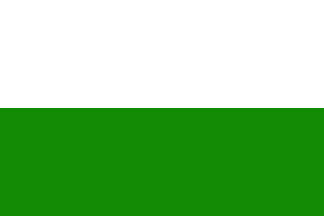 image by Ivan Sache, 9 October 2018
image by Ivan Sache, 9 October 2018
Instituto Integrado de Comercio, located in Barbosa (Santander Department) is
composed of Instituto Integrado de Comercio (main seat), Escuela Urbana El
Centro, Escuela Urbana Santafe, Escuela Urbana Marsella, Escuela Urbana Gaitan,
Escuela Rural Francisco de Paula Santander, Escuela Rural Buenavista, Escuela
Rural Pozo Negro, and Escuela Rural El Amarillo.
The flag of Instituto
Integrado de Comercio is horizontally divided white-green. White means safety
and limpidity. Considered as the color of perfection, it conveys a positive
connotation. White is associated with light, kindness, innocence and purity.
Green means life and represents harmony, growth, renewal, exuberance, fertility
and freshness. Green is strongly connected at the emotional level with safety.
It suggests stability and resistance.
http://inscomercio.edu.co/category/quienes-somos/
School website
Ivan Sache, 9 October 2018
The description of the coat of arms is as follows (translated from the
original, in Spanish):
"Constituent elements
Images that represent the
three specialties offered by the institution: SCIENCE, INFORMATICS AND COMMERCE.
Atom: Science, evolution and constant growth.
Computer: It is the fundamental
tool for the management of information and communication.
Accounting balance:
Indicates the financial equilibrium of commercial companies. It is based on the
"double entry system" of accounting operations."
It was established in
the 1960s.
Sources:
http://inscomercio.edu.co/category/quienes-somos/ and
http://inscomercio.edu.co/category/promociones/page/6/
Esteban
Rivera, 10 October 2018
 image by Ivan Sache, 17 January 2009
image by Ivan Sache, 17 January 2009
"Escuela Nacional de Comercio" is located in the
borough of Candeleria, part of the Federal District of Bogotá.
The flag of the institute, as shown graphically on the website
of the institute, is horizontally divided white-green-white.
Ivan Sache, 17 January 2009
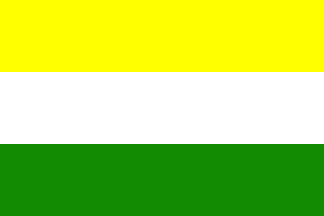 image by Ivan Sache, 3 January 2021
image by Ivan Sache, 3 January 2021
Instituto Técnico Nacional de Comercio was established on 6 May 1953 by
Eustaquio Medina in Cúcuta (Norte del Santander Department), as Escuela Nacional
de Comercio.
The flag of the institute is horizontally divided yellow-white-green. The yellow stripe represents the main task of the
institute, commercial education and teaching of commercial jobs. The white
stripe is a symbol of beauty, honesty and transparency. The green stripe is a
symbol of hope and of the future of the educational community.
Source:
http://instenalcucuta.edu.co/wp-content/themes/ElegantNews/archivos/ManualdeConvivenciaInstitutoNacionaldeComercio.pdf
- Institute's Etiquette Guidebook
Photo:
http://www.instenalcucuta.edu.co/wp-content/themes/ElegantNews/jdgallery/slides/3.jpg
Ivan Sache, 01 August 2014
Photo
https://www.facebook.com/InstitutoTecnicoNacionalDeComercioCucuta/photos/174592479339456
Ivan Sache, 3 January 2021
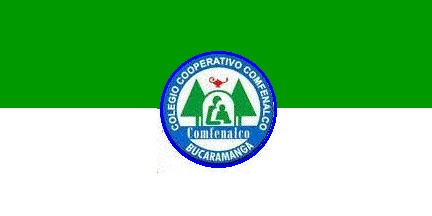 image by Ivan Sache, 23 July 2014
image by Ivan Sache, 23 July 2014
Colegio Cooperativo Fenalco was established on 4 January 1972 in Bucaramanga
(Santander Department), as Cooperativa Especializada de Educacion de Comfenalco.
Classes started on 16 February 1972. The institute is managed by Comfenalco (Caja
de Compensación Familiar de Fenalco). Fenalco (Federación Nacional de
Comerciante) was established in 1945. The Cajas de Compensación Familiar are in
charge of the Family Subsidizing System, prescribed by Law No. 21 of 22 January
1982; their duties are prescribed by Law No. 789 of 27 December 2002.
The
flag of the institute is horizontally divided green-white, with the institute's
emblem in the middle. The emblem was added in 1975 to the
white-green flag adopted in 1972 when the institute was established. Green
is a symbol of aspiration to a future filled with great expectations. Green is
also a symbol of the cooperative movement and conveys a value of universal
solidarity. White is a symbol of honesty and purity.
The emblem of the
institute was adopted in 1975 following an internal contest. The shield, of
circular shape, features on a white background two green pines - the symbol of
the cooperativist movement - flanking the emblem of the Caja de Compensación
Familiar de Fenalco; above is placed a red oil lamp supplying the light of
knowledge.
http://historiacomfenalquista.blogspot.fr/2009/08/insignias-del-colegio-cooperativo.html
- Student's blog
Photo
http://3.bp.blogspot.com/_geMexfqIXgk/SpGz4BCzveI/AAAAAAAAAEU/-IcBuLWu62U/s320/entrega+iso.bmp
Ivan Sache, 23 July 2014
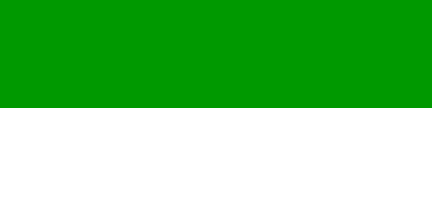 image by Ivan Sache, 23 July 2014
image by Ivan Sache, 23 July 2014
The Colegio de la Compañía de María - La Enseñanza (Medellín), colloquially
known as La Enseñanza, has a
flag which is a horizontal flag, with white (top) and light blue (bottom),
same proportion of the colors, with the
CoA in the middle.
Additional information here: La Enseñanza (official website):
http://www.laensenanza.com/
One final detail on this thread: this school was established on February 26,
1899.
Source:
http://www.laensenanza.com/web/index.php?option=com_content&view=article&id=22:aniversario-del-colegio&catid=49:actividades-2010&Itemid=109
Esteban Rivera, 6 September 2010
More specifically, what is shown in the middle of the flag is the insitute's
seal, made of the institute's coat of arms placed on a golden disk, whose border
is inscribed "COMPANIA DE MARIA" (top) / "JUANA LESTONNAC".
St. Joan of Lestonnac (Jeanne de Lestonnac, 1556-1640; canonized on 15 May
1949), was a niece of the French philosopher Michel de Montaigne. Following the
death of her husband, she took the coat in 1602 in a Cisterican monastery; in
1607, she founded the Company of Mary Our Lady ("Compagnie de Marie Notre Dame",
in short, "Compagnie de Marie"; Compañía de María " La Enseñanza "), a religious
order that was approved by Pope Paul V. The order has today 2,500 members living
in 17 countries. http://www.lestonnac.org/
The shield of the order has a blue background, symbolizing perseverance,
nobleness, loyalty, zeal and justice. In the middle of the shield, the Marian
monogram recalls the key involvement of Mary in the order. In the upper part of
the shield, the glorious cross is a symbol action and resurrection. In the lower
part of the shield, the rose is a symbol of love. The green branches of white
lilies surrounding the shield are a symbol of integer life and hope.
The shield is crowned by twelve stars, the apocalyptic symbol of Mary. The
shield anthem recalls in the third stanza the main elements of the shield, that
is, the lilies, Mary's name, the rose and the cross, and ended with the promise
to die for the flag if required.
Ivan Sache, 6 September 2010
There is another High School with the same name, besides the one located in the
city of Medellín. This one is in the city of Pereira, and has the following
symbols:
http://laensenanzapereira.edu.co/laensenanza/index.php?option=com_content&task=view&id=13&Itemid=31
The only difference being the flag:
http://laensenanzapereira.edu.co/laensenanza/imagenes/bandera.jpg
Esteban Rivera, 21 May 2011